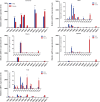Spatial Expression Analysis of Odorant Binding Proteins in Both Sexes of the Aphid Parasitoid Aphidius gifuensis and Their Ligand Binding Properties
- PMID: 35600304
- PMCID: PMC9115719
- DOI: 10.3389/fphys.2022.877133
Spatial Expression Analysis of Odorant Binding Proteins in Both Sexes of the Aphid Parasitoid Aphidius gifuensis and Their Ligand Binding Properties
Abstract
In China, Aphidius gifuensis is one of the most common endoparasitoids of the green peach aphid Myzus persicae and grain aphid Sitobion miscanthi in the field. Insect odorant-binding proteins (OBPs) play vital roles in odor perception during feeding, host searching, mating and oviposition. In addition, some OBPs are involved in other physiological processes such as gustation and reproduction. In the present study, a comparative antennal transcriptomic analysis was applied between male and female A. gifuensis. The spatial expression patterns among antennae, heads, thoraxes, abdomens and legs of OBPs in both sexes were further profiled. Fifteen AgifOBPs were predicted, and 14 of them were identified by gene cloning, including 12 classic OBPs and 2 min-C OBPs. As expected, all OBPs were mainly expressed at high levels in antennae, heads or legs which are sensory organs and tissues. Finally, ligand binding properties of 2 OBPs (AgifOBP7 and AgifOBP9) were further evaluated. Female leg specifically expressed AgifOBP9 displays a broad and high binding property to aphid alarm pheromones, plant green volatiles and aphid sex pheromones (Ki < 10 μΜ). However, female leg specifically expressed AgifOBP7 displays poor affinity for all tested ligands except CAU-II-11 ((E)-3,7-dimethylocta-2,6-dien-1-yl-2-hydroxy-3-methoxybenzoate), a reported (E)-β-farnesene (EBF) analog with an exceptionally high binding affinity (Ki = 1.07 ± 0.08 μΜ). In summary, we reported the spatial expression pattern of the OBP repertoire in A. gifuensis, and further studied the binding properties of OBP7 and OBP9, which are mainly expressed in female legs, laying the foundation for the dissection of the contribution of OBPs to chemosensation in A. gifuensis.
Keywords: Aphidifus gifuensis; fluorescence binding assay; odorant binding protein; spatial expression pattern; transcriptome.
Copyright © 2022 Jiang, Qin, Jiang, Xu, Francis, Fan and Chen.
Conflict of interest statement
The authors declare that the research was conducted in the absence of any commercial or financial relationships that could be construed as a potential conflict of interest.
Figures





Similar articles
-
Functional analysis of odorant-binding proteins for the parasitic host location to implicate convergent evolution between the grain aphid and its parasitoid Aphidius gifuensis.Int J Biol Macromol. 2023 Jan 31;226:510-524. doi: 10.1016/j.ijbiomac.2022.12.060. Epub 2022 Dec 9. Int J Biol Macromol. 2023. PMID: 36509203
-
Coordinative mediation of the response to alarm pheromones by three odorant binding proteins in the green peach aphid Myzus persicae.Insect Biochem Mol Biol. 2021 Mar;130:103528. doi: 10.1016/j.ibmb.2021.103528. Epub 2021 Jan 19. Insect Biochem Mol Biol. 2021. PMID: 33482303
-
The morphology and molecular mechanisms of enhanced olfaction in the grain aphid Sitobion miscanthi.Int J Biol Macromol. 2025 Feb;289:138475. doi: 10.1016/j.ijbiomac.2024.138475. Epub 2024 Dec 16. Int J Biol Macromol. 2025. PMID: 39694385
-
Three odorant binding proteins may regulate the behavioural response of Chrysopa pallens to plant volatiles and the aphid alarm pheromone (E)-β-farnesene.Insect Mol Biol. 2017 Jun;26(3):255-265. doi: 10.1111/imb.12295. Epub 2017 Mar 1. Insect Mol Biol. 2017. PMID: 28247518 Review.
-
An overview of odorant-binding protein functions in insect peripheral olfactory reception.Genet Mol Res. 2011 Dec 8;10(4):3056-69. doi: 10.4238/2011.December.8.2. Genet Mol Res. 2011. PMID: 22180039 Review.
Cited by
-
Molecular Characterization of Chemosensory Protein (CSP) Genes and the Involvement of AgifCSP5 in the Perception of Host Location in the Aphid Parasitoid Aphidius gifuensis.Int J Mol Sci. 2024 Jun 9;25(12):6392. doi: 10.3390/ijms25126392. Int J Mol Sci. 2024. PMID: 38928098 Free PMC article.
-
D-Limonene Affects the Feeding Behavior and the Acquisition and Transmission of Tomato Yellow Leaf Curl Virus by Bemisia tabaci.Viruses. 2024 Feb 15;16(2):300. doi: 10.3390/v16020300. Viruses. 2024. PMID: 38400075 Free PMC article.
References
-
- De Moraes C. M., Lewis W. J., Paré P. W., Alborn H. T., Tumlinson J. H. (1998). Herbivore-infested Plants Selectively Attract Parasitoids. Nature 393 (6685), 570–573. 10.1038/31219 - DOI
LinkOut - more resources
Full Text Sources
Research Materials

